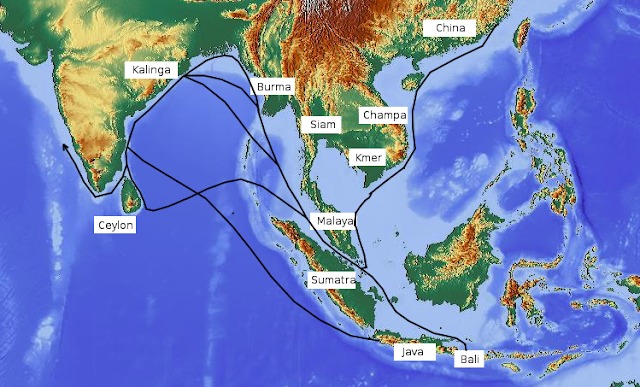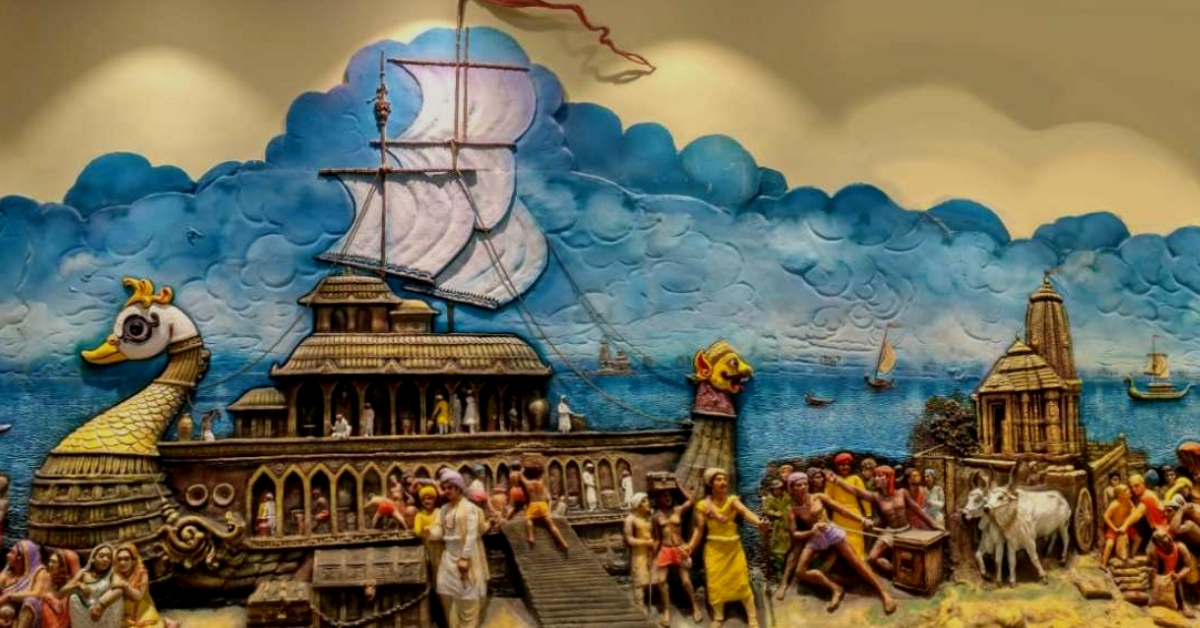Ballads of Bali Yatra: Unique Odisha Festival Celebrates India’s Ancient Links to Indonesia!
“By the end of the second century BC, Indian mariners appear to have learned enough about the monsoon winds and ocean currents to attempt a more southern route across the Indian Ocean to the islands of Indonesia. Odisha’s Lake Chilika was an important starting point for this voyage.”

On the first full moon night of November, just as the winds are getting stronger and winter is setting in, men and women in Cuttack, Odisha assemble near the Mahanadi river, singing ‘Aa ka Ma Boi, Pana Gua Thoi, Pana Gua Tora, Masaka Dharama Mora,’ a prayer to the Gods to keep the sailors safe and wish them a successful voyage.
And although there are no sailors to be seen, small boats made of paper and cork, with diyas placed inside, are left afloat in the river.
Interestingly, this age-old tradition has a deep-rooted connection with Bali, Indonesia!

Sanjeev Sanyal, an urban theorist and author, writes in his book, The Ocean of Churn, “By the end of the second century BC, Indian mariners appear to have learned enough about the monsoon winds and ocean currents to attempt a more southern route across the Indian Ocean to the islands of Indonesia. Odisha’s Lake Chilika was an important starting point for this voyage.”
In the 2nd century AD, Palur was an essential port in Odisha. Back then, what is now the state of Odisha was a part of the Kalinga state, ruled by Emperor Ashoka and trade with China, Rome and countries in South East Asia was flourishing. Bali had spices, pearls gems, silk, camphor, beeswax and sandalwood to offer to the Kalinga traders and the Indian traders travelled for months on end to obtain these.
“Note that the ships did not sail out directly for Indonesia. Instead, they used the north-eastern monsoon winds that blow from mid-November to sail down the coast to Sri Lanka.
This was already a well-known route, and the merchants probably stopped along the way to trade as well.

In Sri Lanka, the ships would have taken in fresh water and supplies before using ocean currents to cross the Indian Ocean to the northern tip of Sumatra (called Swarnadwipa or Island of Gold in Sanskrit texts). From here, the ships could choose to sail down the Straits of Malacca towards Palembang and take the sea route to Borneo and Vietnam. Alternatively, they could head south hugging the western coast of Sumatra to Bali and Java (called Yavadwipa, or Island of Barley/Grain),” writes Sanyal.
As the sailors set sail to travel to foreign countries for several months, it was a tradition for women to see them off at the banks of the river or lake. The sailors began their voyage on the day of “Kartik Purnima,” and the women would gather and pray for the safe journey of their husbands and relatives.
You may also like: At 12, This Odisha Boat Boy Faced British Bullets To Become India’s Youngest Martyr
From the 2nd century BC to 8th century AD, trade relations between Kalinga and Indonesia were very strong before the Arab maritime domination reduced the frequency of the Kalinga traders to the islands.
These centuries of trade relations between the two states cemented the alliance between traders and rulers from Kalinga and those in Indonesia. So much so, that it is believed that the islands of Java and Bali derive their name from the names of Odia kings!
Sir William Wilson Hunter, a Scottish historian, writes,
“The memorials of the Yavana kingdom in Central India record a similar voyage (to that of Alexander’s sail down from the Indus and Ganges)…

The same spirit would doubtless tempt the Yavanas- or, as the word is spelt is Orissa, the Javan, on more distant expeditions. As a matter of fact, the islands of Java and Bali were colonised from the Kalinga or Orissa coast in the first century AD, and a five hundred years later, an Orissa harbour formed the starting place for a voyage to the Java Archipelago… This conjecture obtains a further probability from the fact that Bali, the sacred island of the Javanese, bears the name of the hero in the Indian epic, whose kingdom tradition assigns to Orissa.”
You may also like: Remembering Odisha’s Gandhi: A Forgotten Hero Every Indian Needs to Know About
Since Bali was an important port and city, this tradition came to be known as Bali yatra (or Bali Jatra), meaning a voyage to Bali. Even today, several centuries after the maritime days are long over, Odisha celebrates Bali yatra, in symbolic commemoration of the ancient farewell for the sailors. “This customary ritual is followed by a week-long carnival of commerce, culture and much celebration,” Sudip Sen, the director of Resource Indica: Roots & Revelations, told the Hindustan Times.
“By celebrating Bali Yatra, we seek to revive the old connectivity and people to people contact which became the basis of emotional closeness between the people of Odisha and Bali. Today, when you visit Odisha or Bali, you can see how the cultural traits and habits of the close relationship remain as if frozen in time,” adds Sidharto Reza Suryodipuro, the ambassador at the Embassy of the Republic of Indonesia in Delhi.
(Edited by Gayatri Mishra)
Feature image source: Max Pixel.
Like this story? Or have something to share?
Write to us: [email protected]
Connect with us on Facebook and Twitter.
If you found our stories insightful, informative, or even just enjoyable, we invite you to consider making a voluntary payment to support the work we do at The Better India. Your contribution helps us continue producing quality content that educates, inspires, and drives positive change.
Choose one of the payment options below for your contribution-
By paying for the stories you value, you directly contribute to sustaining our efforts focused on making a difference in the world. Together, let’s ensure that impactful stories continue to be told and shared, enriching lives and communities alike.
Thank you for your support. Here are some frequently asked questions you might find helpful to know why you are contributing?


This story made me
-
97
-
121
-
89
-
167













